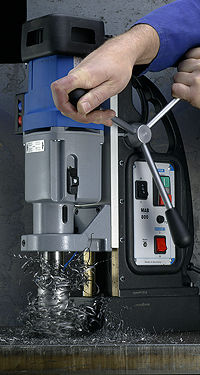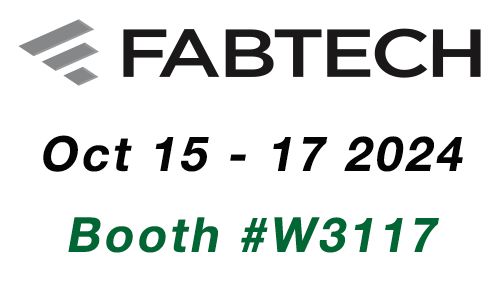Portable Magnetic Drills Frequently Asked Questions
Q. What is a magnetic drill?
A. A magnetic drill, or mag drill, is a drill that adheres to and cuts into metal - iron, stainless steel, Titanium, Inconel and other similar materials. A magnetic drill consists of a magnetic base, a drill motor, a drill body, and an arbor or chuck. Our mag drills for sale by CS Unitec are all produced according to the highest quality standards.
Q. What are the advantages of using a portable magnetic drill?
A. Portable magnetic drills have a number of advantages when compared to hand held drills. A portable magnetic drill offers:
- Increased stability
- Decreased drilling fatigue
- Better accuracy and hole quality
- Fast cutting of large diameter holes
- Easy maneuvering
Q. What applications often use magnetic drills?
A. The following applications often use magnetic drills:
- Fabrication
- Welding
- Building and Construction
- Truck, RV, & Special Vehicle Builds
- Ship Building
- Oil & Gas Pipeline, Offshore, and Oil Fields
- Power Utilities
- Railroad Industr
- Maintenance Facilities
- Bridge Construction
Q. How do I select the right magnetic drill for the job?
A. For desired results, it is very important to choose the right drill. The selection of the magnetic drill depends on the following:
- Diameter of hole
- Depth of hole to be drilled (D.O.C. Depth of Cut)
- Drilling speed requirements
- Number of holes
- Work environment
- Space / physical limitations
- Type of material to be drilled
- Is tapping, reaming or countersinking needed
For help selecting a drill, use our drill finder software or contact one of our technical experts at 800-700-5919.
Q. What machine features are important when evaluating magnetic drills?
A. When evaluating magnetic drills, the following are most important:
- Reversible motors are required if the application involves tapping, reaming or countersinking
- Integrated magnet overheat protection (CoolMag™) ensures magnets don’t overheat in jobs where the drill will be on for long periods of time
- Electronic sensors can detect if sufficient adhesive force is present for drilling and automatically turn off the drill motor if a magnetic drill is not adhered to the surface
- Power cables integrated into the machine casing reduce chance of getting caught, tearing or snapping off
- Electronic torque control prevents damage to motor
Q. What do you need for a magnetic drill to work?
A. When using a magnetic drill follow these important guidelines:
- The material to which the drill will adhere must be ferrous metal. Vacuum plates and pipe saddles are available for use on non-ferrous or irregularly shaped materials
- Make sure the metal is flat and reasonably clean for proper magnetic adhesion
- Minimum material thickness of 3/8” is required for smaller magnetic drills and ½” thickness for larger magnetic drills
- A secured safety lanyard or safety chain connected to the drill
- Appropriately sized annular cutter or twist drill bit
- Cutting lubricant is recommended to optimize cutter life
Q. What are the material requirements for a magnetic drill?
A. A magnetic drill requires a ferrous material with a clean, smooth, flat surface for safe magnet adhesion. Ferrous materials are materials that contain Iron, including steel, carbon steel, alloy steel, cast iron wrought iron, etc. If you are drilling into a non-ferrous metal, the use of a vacuum plate or secure sandwiching of steel plates is recommended.
Q. What can cause my magnetic drill magnet to have reduced holding power?
A. Reasons for reduced holding power include:
- Material less than 3/8” thick
- Corrosion on surface of material
- Magnet only partially positioned on the workpiece
- Foreign material-metal chips, dirt, debris and grease between the magnet and adhesion material
- Curved surface - a surface should be flat for magnet adhesion. For pipe drilling applications a pipe clamp should be used.
Q. Can I use a magnetic drill horizontally or upside down?
A. Yes! A portable magnetic drill can be positioned to meet your drilling needs. It can be used to drill horizontally, vertically or overhead (upside down) and allows you to drill on-site instead of trying to bring the workpiece to the drill. Cutting pastes are recommended in place of cutting fluid for drilling on vertical and overhead surfaces. Your magnetic drill should be securely fastened with a safety lanyard or safety chain at all times.
Q. Is a safety chain or safety strap necessary?
A. Yes! You should use a safety strap or safety chain with your portable magnetic drill at all times. A safety strap/chain is necessary for operator safety to prevent the magnetic drill from falling during loss of supply power.
Q. Do I need to use cutting lubricant?
A. While not required, cutting lubricants will significantly increase the life of any annular cutter or drill bit you use. CS Unitec has liquid and paste style cutting lubricants available for most of your drilling needs. CS Unitec cutting lubricants are available in water soluble and biodegradable varieties.
Q. Can my magnetic drill magnet overheat?
A. Magnetic drill magnets can overheat if a magnetic drill is left on for a very long period of time. Most of our magnetic drilling machines are equipped with a CoolMag™ system that prevents the magnet from overheating during prolonged use. Most of CS Unitec’s magnetic drills are also equipped with electronic safety shutoffs.
Q. Is it possible to use a mag drill without electricity?
A. Yes! Some of our CS Unitec magnetic drilling machines are pneumatic or hydraulic powered. Portable pneumatic magnetic drills use air from a compressor as their power source, making them safer in hot work zones. Portable hydraulic magnetic drills use hydraulic fluid from a pump system and don’t require electricity – allowing them to be used above or below water.
Q. How do I extend the life of my annular cutter or drill bit?
A. Annular cutters and drill bits can vary in life expectancy based on a number of factors. To maximize the life of your cutting tools, use appropriate cutting lubricants, use optimal speed and feed (rpm and feed rate) for the size bit being used, and apply equal and constant pressure to cutting tool. During use of an annular cutter the chip flow should be mostly constant and form a mesh like birds nest. You can significantly increase your cutter life by switching to an automatic-feed drill. Automatic-feed drills apply optimal pressure to the drilling surface at all times, reducing strain on the cutter and decreasing cutting time and user error.
Q. What causes annular cutters to dull or break?
A. The main reason annular cutters dull is due to slow feed rates. With slower feed rates most users apply too much pressure to try to increase cutter performance. Using firm and constant feed pressure throughout the depth of cut will maximize annular cutter performance and extend the life of the cutter and tool.
Q. What is slug ejection?
A. Slug ejection occurs at the completion of the cut when the core of cut material (aka Slug) is ejected from the annular cutter. This action occurs from the spring action of the pilot pin inside the annular cutter and arbor body.
Q. What can cause a slug to stick?
A. A slug can stick in an annular cutter due to insufficient lubrication or a dull cutting edge. If your cutting slugs continue to stick inside of the annular cutter, increase lubricant flow. If slug ejection continues to be irregular, consider sharpening or replacing your cutter. The POW 200 multipurpose tool is useful for cleanup and manual slug ejection.
Q. Should I use an automatic-feed or power-feed drill?
A. Auto-feed drills (power-feed drills) can dramatically increase productivity and reduce cutting tool cost. Automatic-feed drills apply steady, direct pressure to the workpiece, improving cutting efficiency. CS Unitec auto-feed drills have an automatic drill motor shut off after cut completion. This feature allows operators to run multiple drills at a time, increasing output. When the cut is completed, CS Unitec auto-feed drills automatically retract and power down the drill motor.
 Urgent Weekend/Holiday Fulfillment Available - Click For Details
Urgent Weekend/Holiday Fulfillment Available - Click For Details 





